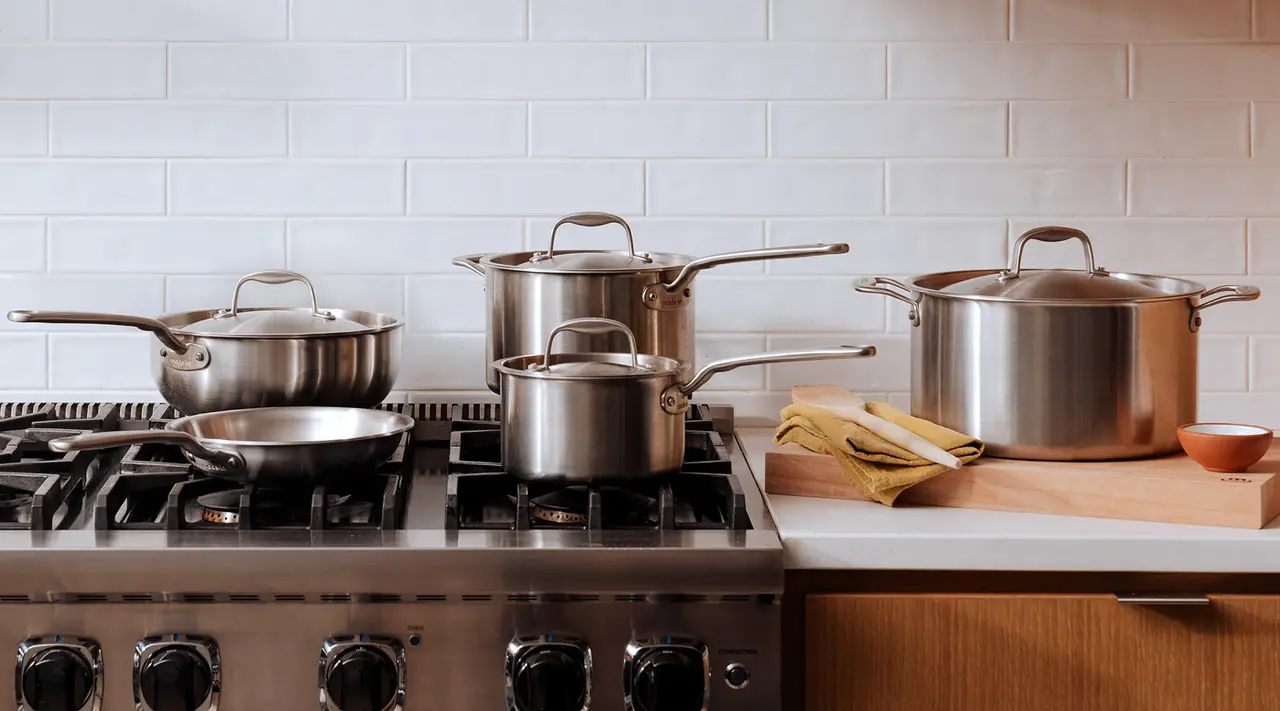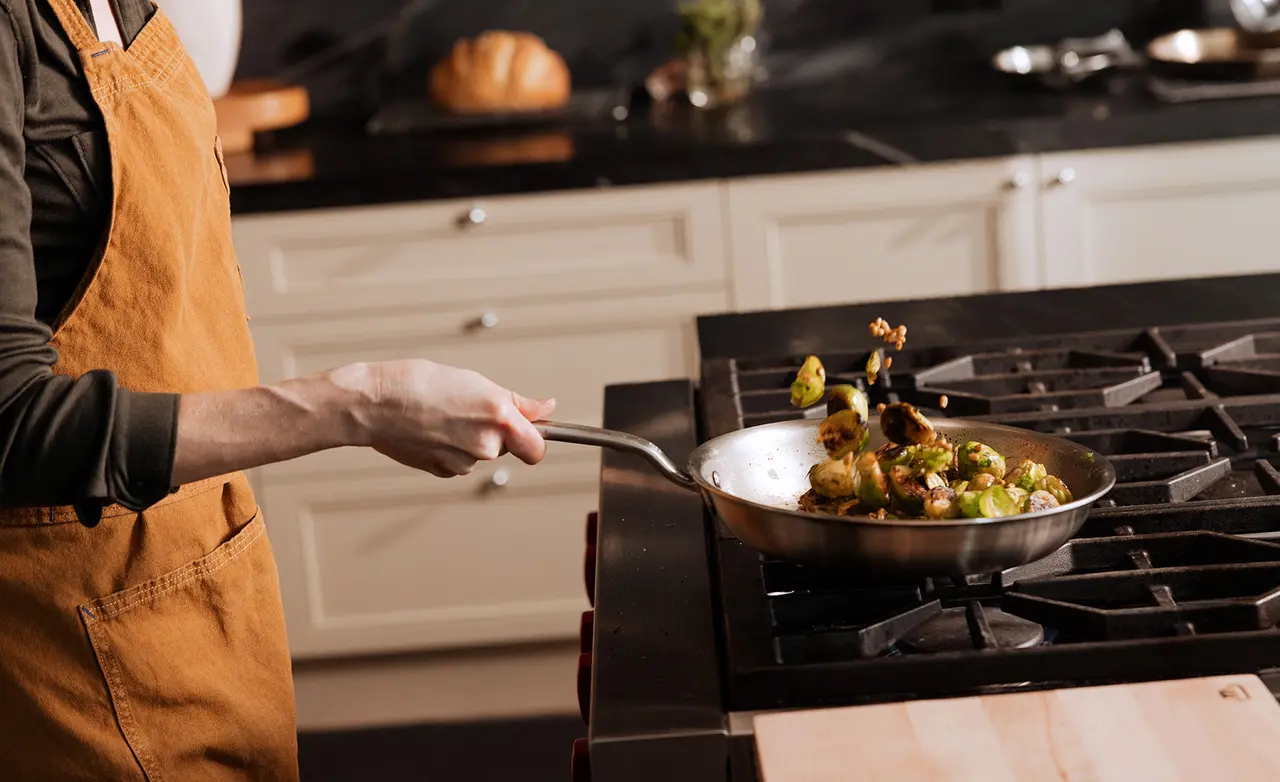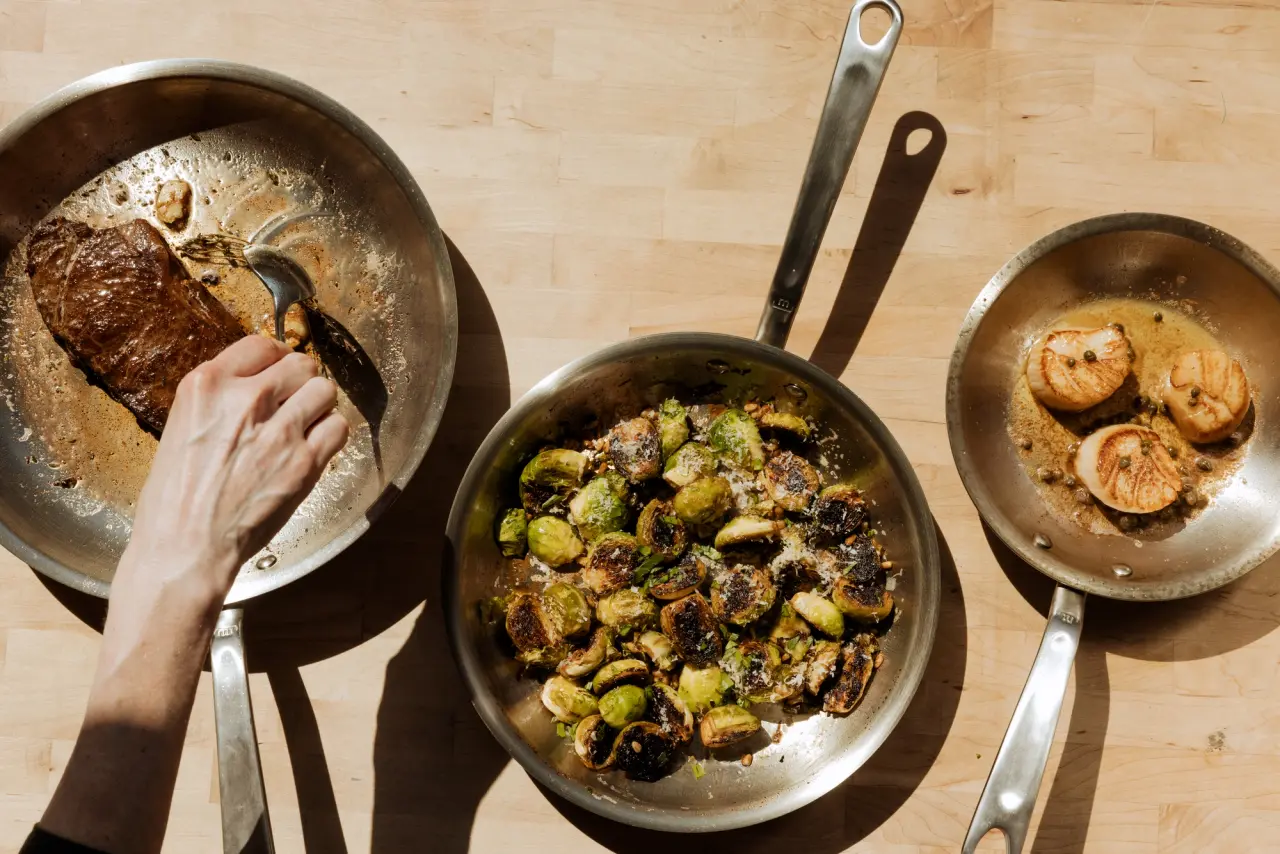If you asked us to build a kitchen setup from scratch, we can say for certain that stainless steel would be one of the first pieces added. Wonderfully versatile, long-lasting, and relatively low-maintenance, a great piece of stainless steel cookware is well worth the investment. But with the sheer number of stainless steel products—and huge range of prices—on offer, how do you choose the best one?
Allow us to be your stainless steel guides. As producers of Made In Cookware's Award-Winning Stainless Clad Cookware, we know what makes for quality construction. From the types of metals used, to why a fully-clad pan is the best choice, here’s how to shop for your new stainless steel cookware.
What are the Benefits of Stainless Steel Cookware?
At its very best, stainless steel cookware is a joy to cook with—not only is it a great conductor of heat, but it’s highly durable and long-lasting as well.
Durability and Longevity
Not all stainless steel is created equal. Stainless steel cookware, like Made In Cookware, is made from 18/10 Stainless Steel—the highest grade—is particularly strong and durable, due to the higher percentage of chromium mixed in.
Non-Reactive Surface
Stainless steel—especially high-grade stainless steel—is a non-reactive material, meaning that it’s more resistant to corrosion and rust than other types of metals.
This also means that your cookware won’t react with acidic ingredients like tomatoes or wine, which can produce metallic flavors in cast iron, carbon steel, or other reactive cookware materials.
Easy Maintenance
Cleaning stainless steel is fairly straightforward. Unlike materials like carbon steel or unfinished cast iron, you won’t need to worry about stripping the seasoning or scratching the coating (though you can scratch the finish with sharp-edged utensils or using a knife to cut ingredients in the pan). And you can pretty much always restore stainless to its original shiny finish, no matter how grimy or burnt-looking it is when you're done cooking.
Excellent Heat Distribution and Retention
While stainless steel is not a great conductor of heat on its own, stainless steel that’s “cladded,” or layered with more conductive metals like aluminum, conducts heat extremely well. This cladding also helps with heat retention and distribution, so your pan won’t develop hot spots or cook your food unevenly. When you are shopping for stainless steel cookware, make sure you look for clad cookware, such as Made In's 5-Ply Stainless Clad, which thousands of chefs and millions of home cooks rely on for its professional-grade heat distribution and searing abilities.
Key Stainless Steel Features to Consider
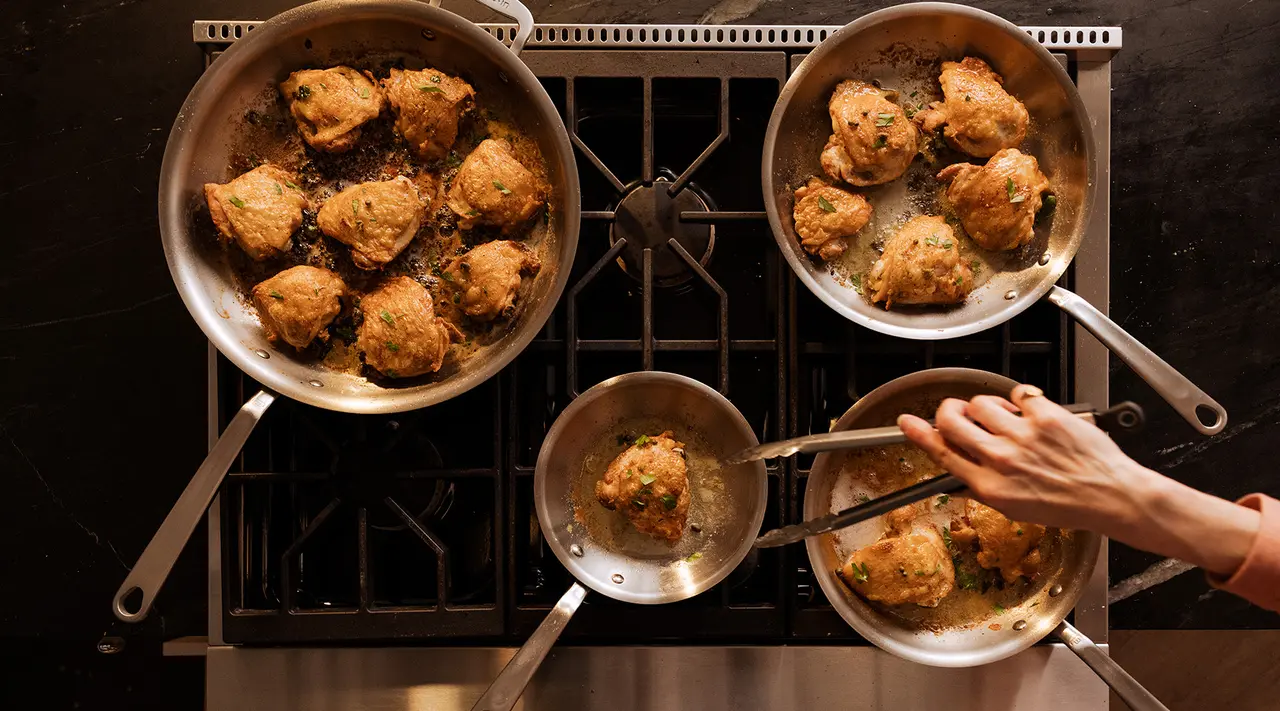
Here are a few key indicators of quality that can help you when shopping for the best stainless steel cookware.
Material Quality and Grade
As we touched on earlier, stainless steel comes in a range of different grades. The highest, 18/10, indicates a higher ratio of chromium to nickel, which not only makes for a more durable pan, but one that’s oven-safe as well—a huge reason why stainless is so commonly found in restaurant kitchens. Stainless steel also comes in other grades, such as 18/8 and 18/0. These are lower grade materials and more susceptible to rusting over time.
Most high-quality stainless cookware also works on induction stoves. Make sure to look for the phrase “induction-compatible” on the packaging, or for the induction symbol, which looks like a coil of wire. But, don't stop there! When shopping for induction-compatible cookware, you want cladded cookware where the induction layer is built into the cookware, as this will provide more even heat distribution on induction stovetops. For instance, Made In Cookware's 5-Ply cookware's bottom layer is a magnetic layer, making it not only induction-compatible, but induction-optimized. Cheaper cookware options, such as Caraway or Our Place, will paste or bolt an induction plate on the bottom of the cookware, making for uneven heating and poor durability.
Cookware Ply
You’ll typically see stainless pots and pans described as “3-Ply” or “5-Ply.” The “ply” of a pan means that the steel has been layered with more conductive metals like aluminum—for example, each piece in Made In's Stainless Clad Collection is cladded with pure aluminum, aluminum alloy, and 18/10 stainless steel. The number associated with ply indicates how many layers have been cladded together—in our case, 5. In general, the more ply's the better, so 5-Ply is better than 3-Ply.
Made In's 5-ply stainless makes for a durable piece of cookware that’s more resistant to warping and dents and does a stellar job of distributing heat.
Handles and Lids
A stainless steel pot or pan should have a sturdy, comfortable handle, as well as a “helper handle” for larger sauciers and saute pans. Because stainless cookware often sits on the stove for extended periods, handles and lids can get dangerously hot—that’s why at Made In we added a Stay Cool Handle™ to our Stainless Clad Collection for an extra layer of safety.
How to Choose the Best Stainless Steel Cookware
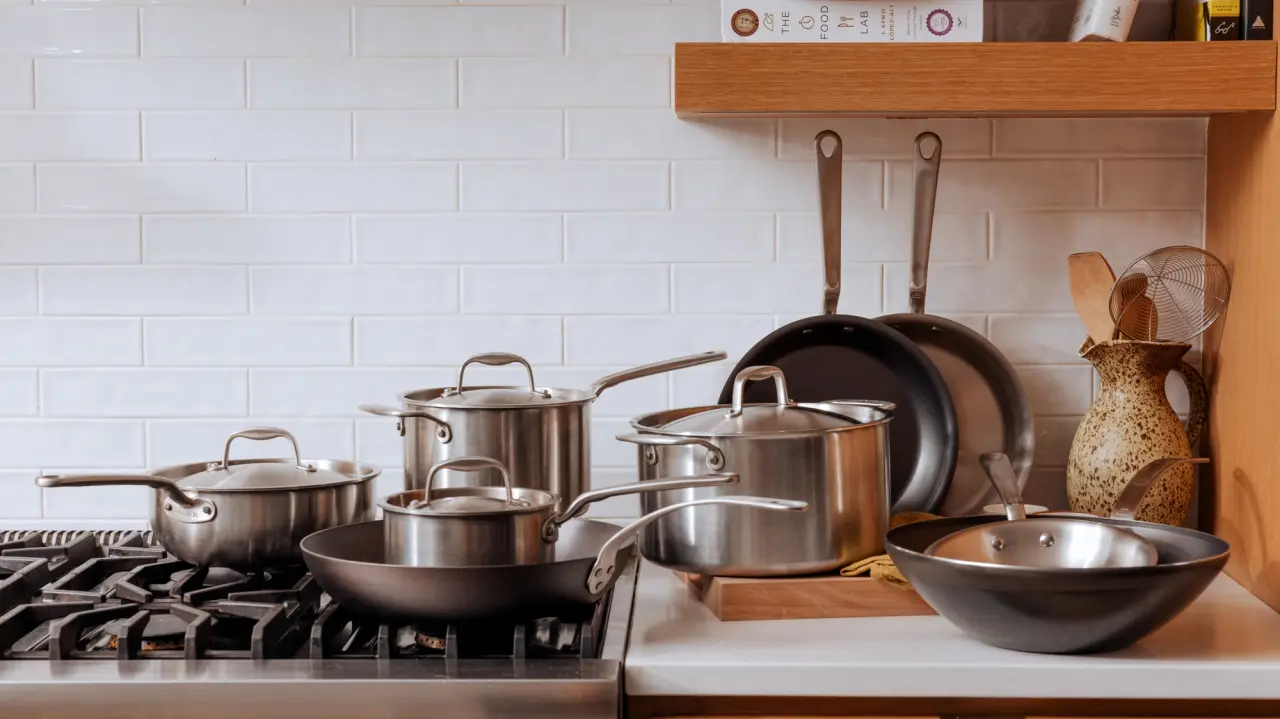
Now you know what goes into a quality piece of stainless cookware, here’s how to shore up all that information with your budget and cooking needs.
Consider Your Cooking Style and Needs
Stainless steel is compatible with a wide range of cooking methods: use it to sear, stir-fry, braise, or even grill. For that reason, you don’t have to be a seasoned cook to justify bringing a piece of stainless into the mix. Plus, a great piece of stainless cookware can help level up your home cooking game.
That being said, you should invest in stainless steel if you do a lot of searing or other high-heat cooking, which is where stainless steel excels.
If you are looking for a pan that will last a lifetime, you will want to invest in high-quality stainless-steel clad cookware like Made In's 5-Ply cookware.
Quality Indicators
A high-quality stainless steel pan should always have these basic traits.
- Made from high-grade stainless steel, ideally 18/10, which indicates a stronger, more durable material.
- Cladded with metals like aluminum for better heat conduction and distribution.
- No induction plate on the bottom. Induction compatibility should be built into the cladding for the highest-quality performance
- Oven-safe
- At least 3-Ply, but preferably 5-Ply
Budget Considerations
Stainless steel cookware tends to be more expensive compared to other materials—especially for high-quality options. For a stainless clad frying pan or pot that’ll last you decades (if not a lifetime), you can expect to pay upwards of $100, and at least $200 for something like a stock pot.
If budget is a big concern, you can get a decent-quality stainless steel frying pan for about $50. You may not get quite the same level of polish, performance, or permanence, but you’ll still get to enjoy the great heat retention and durability of stainless steel.
Stainless Steel Maintenance and Care Tips
Caring for stainless steel cookware isn’t nearly as tricky as you might think, especially if you're new to stainless. Here’s everything you need to know about proper care, cleaning, and storage to keep your stainless steel in tip-top shape.
How to Clean Stainless Steel Cookware
One of the great things about stainless steel cookware is that it’s fairly easy to keep clean. While more prone to sticking than materials like non stick, stainless steel pots and pans don’t have a coating or layers of seasoning to worry about—so you can get a little rough with them.
Here’s our guide to cleaning stainless steel cookware, depending on the degree of mess. You can also read up on how to prevent (and fix) a common rainbow stains cosmetic issue—aka heat tint.
How to Store Stainless Steel Cookware
Since stainless steel is both rust- and corrosion-resistant, you don’t have to worry as much about storage. Just make sure to place a Pan Protector, dish towel, or trivet between your pans if you plan on stacking on them, in order to prevent scratches. After each wash, make sure to immediately and thoroughly dry your pans with a microfiber cloth to prevent water spots.
Common Mistakes to Avoid
Even something as durable as stainless steel has its pitfalls. While these tend to be mainly aesthetic issues, such as stains, scratches, and heat tint, they’re also easy to avoid.
First off: Try to avoid abrasive cleaning products (such as bleach-based cleaners), steel wool, and harsh brushes when cleaning your pot or pan, as these can scratch the finish.
Second, always make sure to hand wash your pan. Even if your pan is labeled as dishwasher-safe, the harsh detergents can cause scratches and discoloration, as well as damage the aluminum layers in your pan—particularly if those layers are slightly exposed, like in our Stainless Clad cookware.
Thirdly, always make sure to salt your pan after heating it: Adding salt to a cold pan, or to water before it’s boiling can lead to tiny divots in your pan known as pitting. While these don’t affect your pan’s performance, they can’t be removed. Read up on how to avoid pitting in our dedicated guide.
Ready to Shop?
A good piece of stainless steel cookware will never let you down. And because we’ve seen everything this durable, versatile cookware can do—from searing a perfect steak to simmering chicken stock—we want to make sure you’re buying the best one.
Each piece of Made In's Stainless Clad Cookware is built from professional-grade materials, making for a restaurant-level cooking experience every time.
